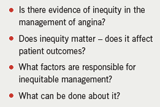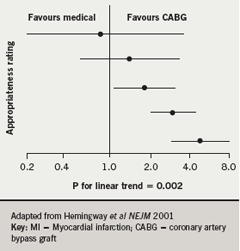Professor Adam Timmis (Barts and the London NHS Trust) discussed the thorny issue of inequity in the management of angina, and he started by distinguishing between inequality and inequity. Inequality, such as differences in health between populations, is “an interesting observation”. For instance, in East London, standardised admission ratios with myocardial infarction rates are twice as high for South Asians as for whites. Also, mortality in women is twice as high following MI (for various reasons). Inequities, in contrast, are represented in different opportunities for healthcare between populations, for example, and “are potential embarrassments for us as cardiologists.” Thus, in 2003, prolonged door-to-needle times were observed in South Asians versus whites (42.5 vs. 26.0 minutes, respectively); and rates of discharge on beta blockers post-MI were lower in women (31.6%) than in men (44.9%).

Key questions on inequity are shown in table 1, many of which are infrequently addressed. Professor Timmis presented evidence that inequity exists from a study involving six UK rapid access chest pain clinics. They had shared databases including almost 9,000 patients with stable chest pain, about 27% of whom were diagnosed with angina and some 73% with non-cardiac chest pain. Patients were rated appropriate or not appropriate for angiography, using the established RAND-UCLA method, by experts. They found that among patients appropriate for angiography only 31% actually received it. This is clear evidence of under-investigation and under-treatment in patients with angina. Analysis showed that patients over 65 years, women and South Asians along with those in the most deprived socio-economic groups were less likely to receive angiography. The study also showed inequity of access to these clinics, most notable in elderly patients and those in the most deprived socio-economic group, reminding us that “deprivation is one of the biggest drivers of coronary mortality in the country,” said Professor Timmis.
Does inequity in the investigation of angina matter? “Here the data are quite consistent and show that in the patients attending chest pain clinics who are deemed appropriate for angiography, failure to obtain angiography in appropriate cases “is associated with worse outcomes,” so inequity “certainly does matter”. This pattern is seen across the board in medicine and these groups, especially the elderly, “don’t do so well in the hands of doctors,” said Professor Timmis.
Physician bias was investigated in a study of 4,121 patients (2,974 of whom were white and 502 south Asian [SA)), referred to a tertiary centre for coronary angiography in the appropriateness for coronary revascularisation (ACRE) study (Feder G et al. BMJ 324:511–16). The intended management by ethnicity for revascularisation was recorded, and was identical between the two patient groups (39% for SA and 40% for whites). However, actual receipt of revascularisation was “significantly lower” in south Asians, so inequity in this particular cohort was not explained by physician bias, “for reasons we have no answers to,” said Professor Timmis. Factors such as coronary anatomy and the patients’ wishes may have been an influence.
Patient-specific factors are other potential drivers of inequity. Many cardiologists are programmed to think that “there is something funny in the way that women present with angina,” similarly with ethnic minorities, yet there is no evidence to support these notions.
Test-specific factors may play a role in inequity. False positive and false negative exercise tests do occur more commonly in women but the prevalence of disease is somewhat lower in women, so the tests will perform less well. Professor Timmis presented data from a large cohort of almost 8,000 patients examining whether women or south Asians present with chest pain symptoms in a “funny way”. Findings show that the prognostic validity of chest pain typically is independent of gender or ethnicity. In women and ethnic minorities “we found absolutely no difference in the prognostic validity of the history they give with angina, nor indeed in the results of stress testing”.
Evidence supports the view that south Asians and female patients do not present in “funny ways”. Women present in exactly the same way as men, and men with positive exercise tests have exactly the same event rate over 2.5 years as women. But men with a negative test “if anything have a rather higher event rate than women with a negative test.” So “if a woman’s got a positive test, she needs investigating in exactly the same way as a man,” in Professor Timmis’s view.
How to tackle inequity
What can be done about inequity in angina? Professor Timmis cited a challenging lead article by Nicole Lurie (Health disparities, less talk, more action. N Engl J Med 2005;353:727–9). This describes the ‘data deluge’ in terms of inequity, which has led many observers to suggest that “it is time to stop documenting disparities and turn our efforts to doing something about them.” To these ends, Professor Timmis described recent work in the development of objective tools for guiding management in the application of appropriateness ratings. Further data from the ACRE study look at five levels of appropriateness. The scale runs from 1–2 (inappropriate) up to 9 (completely appropriate). The grades are determined by an expert panel, which shows a graded dose-related effect of appropriateness which is related to hard outcomes such as MI or death, when comparing medical treatment versus CABG (figure 1). These data appeared to be showing important messages on how patients should be managed.

The technique was applied in a recent randomised controlled study of aids to decision making, in the Appropriateness of Referral and Investigation in Angina (ARIA) Trial (Junghans C et al. Arch Intern Med 2007;167:195–202). This compared the effect of conventional guidelines with appropriateness of investigational decisions in angina, namely exercise testing and angiography. It involved 145 physicians who received patient-specific appropriateness ratings and 147 physicians who received guideline support. All physicians made their recommendations on 12 web-based patient vignettes before and on 12 vignettes after these interventions. Results showed that where decisions were guided by appropriateness ratings, there was a significant increase in the appropriate decisions they made, whereas, the conventional guidelines had no effect.
What, then, is the solution to inequity in the management of suspected angina? Conventional guidelines, although widely used, are not patient-specific and there is little evidence that they change management behaviour. Often “the patient you have in front of you in a clinic just never quite fits the guideline,” said Professor Timmis. The ARIA Trial has shown that, unlike conventional guidelines, patient-specific ratings changed physician testing behaviour and have the potential to reduce practice-based variations and to increase the appropriate use of investigation.
Similarly, risk scores are widely used and objective in their assessment of risk but they provide no information to the physician on appropriate management responses to the risk score.
The message is therefore, that, “appropriate ratings we like”. They are informative, and deployment of patient-specific ratings may be part of the solution to inequity in the management of suspected angina. They are not widely used but “there is increasing recognition of this methodology…and I think this is something for the future which hopefully will have some impact on the inequity in management that patients with angina are receiving,” Professor Timmis concluded.
AT has been a CAB member for CV Therapeutics.
